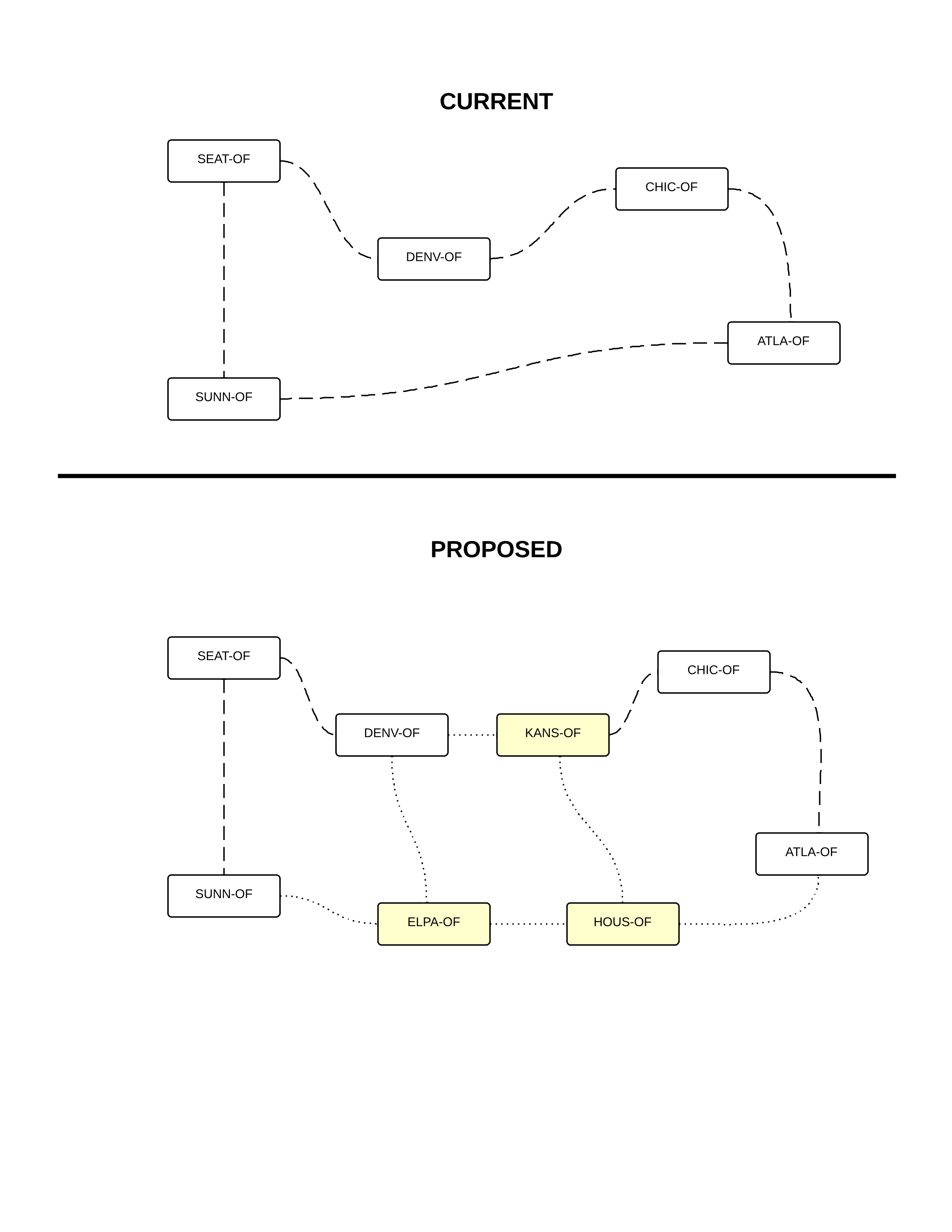| Version 7 (modified by , 10 years ago) (diff) |
|---|
NLR Expansion Plan
NLR is adding three Pica8 switches to their GENI OpenFlow backbone deployment; this page describes the plan for this expansion.
Hardware
Model: Pica8 P-3780 - 48 x 10GE SFP+ Ports
Tech Specs: http://www.pica8.com/documents/pica8-datasheet-64x10gbe.pdf
Firmware
There are two firmware options for the Pica8: L2/L3 and OVS.
L2/L3 Mode - "Standard" Layer2/Layer3 software that supports traditional switching/routing, as well as Openflow version 1.0 - 1.3. In this mode, the each port supports both layer2/layer3 and Openflow forwarding at the same time (Hybrid mode), and Pica8 calls this functionality "cross-flow." This mode has support for the protocols needed by the current NLR operational support model (SNMP and TACACS+). In addition, the CLI used to configure the device is akin to the standard Cisco IOS-XR CLI (commit changes to apply, editable configuration sub-sections, configuration history). Openflow support is basic and lacks some of the additional Openflow mechanisms like generating flows locally from the device.
OVS - PicOS Open vSwitch software mode that only supports Openflow forwarding. This mode supports the same versions of Openflow as L2/L3 Mode. The CLI and functionality of the device is more akin to a Linux server than a traditional router/switch. In this mode, you use two programs, ovs-vsctl and ovs-ofctl, to configure the switch and Openflow functionality on the switch. This mode lacks SNMP support, and therefore will not work for basic NLR operational monitoring and graphing tools. Openflow support in this mode is much more advanced and includes the feature to generate IPv4 flows from the switch locally.
Topology
The new switches will be deployed in Kansas City MO (NLR KANS), El Paso TX (NLR ELPA), and Houston TX (NLR HOUS). They'll add more paths to the current ring, as seen below:
Testing
The switches will be tested in the NLR lab before being deployed, in three phases (which don't correspond at all to the deployment phases below).
Phase 1 testing
- Boot in L2/L3 Mode (Complete)
- Basic configuration template (Complete)
- Username/Password
- SNMP
- TACACS
- Unable to login with "backdoor" username/password if TACACS is enabled. Until this is addressed, TACACS isn't an option
- Unable to configure remote port. Pica8 is aware and will address in future revision.
- SSH Enabled / Telnet Disabled
- Syslogging
- Basic Openflow configuration testing (Complete)
- Enable Openflow globally
- Connect to Flowvisor
- Verify resource advertisement remotely
Phase 2 testing
- Layer1Transport testing
- layer1transport configured on NLR FOAM with test rules
- Configure switch with connection toward layer1transport service
- Generate traffic from BSSW test host
- Verify basic traffic connectivity
- Performance testing?
Phase 3 testing
- BSSW to develop "newer" version of OVS software
- SNMP/TACACS enabled
- CLI similar to L2/L3 Mode
- Future testing?
Deployment
The switches will be deployed into the field in two phases (which don't correspond at all to the testing phases below).
Phase 1 deployment
In the Phase 1 deployment, the switches will be put into the field and connected to each other, but only two ports will be enabled on each, and the layer1transport controller will be used to pass traffic between the two ports, with no experimenter control yet.
NLR HOUS deployment
- Mount/Power
- Connect to NLR Out-of-Band
- Connect to NLR FrameNet for In-Band Management / Control-Plane Traffic
- Verify basic IP Connectivity
- Establish connection to Layer1Transport on NLR FOAM
- Break existing SUNN to ATLA GENI backbone and insert new switch into path
- Port 48 --> Atlanta
- Port 47 --> Sunnyvale (Soon to be El Paso)
- Port 46 --> Kansas City (New Connection / Disabled at this moment)
- Verify GENI backbone connectivity
NLR ELPA deployment
- Mount/Power
- Connect to NLR Out-of-Band
- Connect to NLR FrameNet for In-Band Management / Control-Plane Traffic
- Verify basic IP Connectivity
- Establish connection to Layer1Transport on NLR FOAM
- Break existing SUNN to HOUS to ATLA GENI backbone and insert new switch into path
- Port 48 --> Atlanta (Soon to be Houston)
- Port 47 --> Sunnyvale
- Port 46 --> Denver (Disabled at this moment)
- Verify GENI backbone connectivity
NLR KANS deployment
- Mount/Power
- Connect to NLR Out-of-Band
- Connect to NLR FrameNet for In-Band Management / Control-Plane Traffic
- Verify basic IP Connectivity
- Establish connection to Layer1Transport on NLR FOAM
- Break existing SEAT to DENV backbone and insert new switch into path
- Port 48 --> Chicago
- Port 47 --> Denver
- Port 46 --> El Paso (Disabled at this moment)
- Verify GENI backbone connectivity
NLR DENV maintenance
- Connect 10GE Port (28) toward El Paso
Phase 2 deployment
In the Phase 2 deployment, the switches will be reconfigured to be controlled by the NLR FlowVisor, and the third port on each will be activated, allowing experimenter control and more interesting experimenter topologies.
FIXME: What happens with VLAN 3715 and 3716 in this phase?
FIXME: What happens with auto-approval in this phase, now that NLR FOAM has a mix of VLAN-hybrid and non-hybrid switches?
Final topology/configuration
- Connect all 3 switches to NLR FlowVisor
- Enable 3rd direction on all 3 switches (and Denver HP)
- El Paso --> Denver
- Houston --> Kansas City
- Remove Layer1Transport connectivity on all switches?
Attachments (4)
-
NLR Proposed GENI Backbone.pdf (9.9 KB) - added by 10 years ago.
Version 1.0 of New NLR GENI Backbone
-
NLR-topo.pdf (45.4 KB) - added by 10 years ago.
Pica8 / BSSW Testing Topology
- NLR Proposed GENI Backbone.png (268.3 KB) - added by 10 years ago.
- NLR-topo.png (102.1 KB) - added by 10 years ago.
Download all attachments as: .zip

